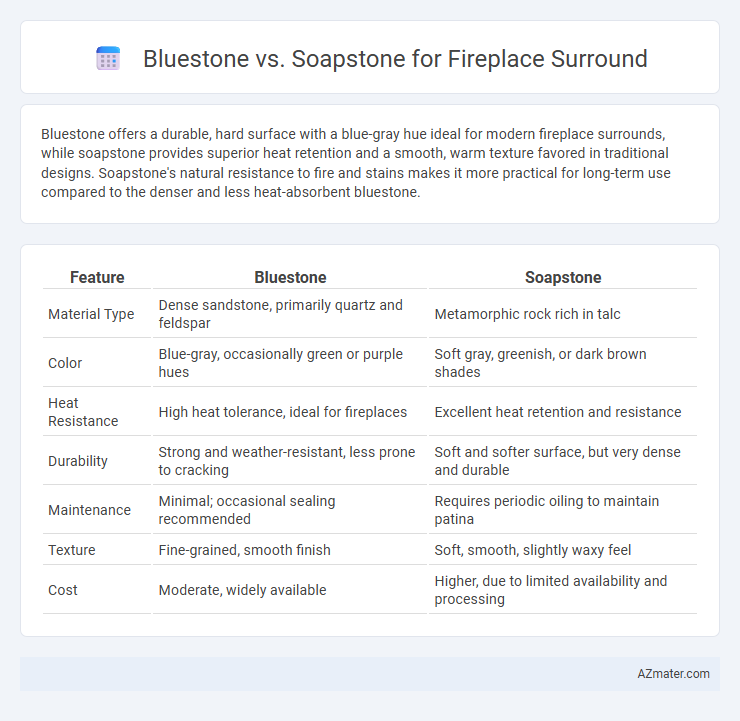Bluestone offers a durable, hard surface with a blue-gray hue ideal for modern fireplace surrounds, while soapstone provides superior heat retention and a smooth, warm texture favored in traditional designs. Soapstone's natural resistance to fire and stains makes it more practical for long-term use compared to the denser and less heat-absorbent bluestone.
Table of Comparison
| Feature | Bluestone | Soapstone |
|---|---|---|
| Material Type | Dense sandstone, primarily quartz and feldspar | Metamorphic rock rich in talc |
| Color | Blue-gray, occasionally green or purple hues | Soft gray, greenish, or dark brown shades |
| Heat Resistance | High heat tolerance, ideal for fireplaces | Excellent heat retention and resistance |
| Durability | Strong and weather-resistant, less prone to cracking | Soft and softer surface, but very dense and durable |
| Maintenance | Minimal; occasional sealing recommended | Requires periodic oiling to maintain patina |
| Texture | Fine-grained, smooth finish | Soft, smooth, slightly waxy feel |
| Cost | Moderate, widely available | Higher, due to limited availability and processing |
Introduction to Bluestone and Soapstone Fireplace Surrounds
Bluestone fireplace surrounds are valued for their durability and unique blue-gray hues, offering a sleek, modern aesthetic that withstands high heat and outdoor conditions. Soapstone, characterized by its soft, smooth texture and natural heat retention properties, radiates warmth long after the fire has died, making it ideal for cozy interior fireplaces. Both materials provide distinct visual appeal and functional benefits, with bluestone emphasizing robust outdoor use and soapstone enhancing indoor comfort.
Material Origins and Composition
Bluestone originates from sedimentary rock formations composed primarily of sandstone and quartz, known for its durability and subtle blue-gray hues. Soapstone, a metamorphic rock rich in talc, features a smooth, soapy texture and exceptional heat retention properties, making it ideal for fireplace surrounds. Both materials offer distinct aesthetic and functional advantages rooted in their unique geological compositions and origins.
Aesthetic Appeal: Color and Texture Comparison
Bluestone offers a rich, vibrant palette with deep blues and subtle hints of green, creating a dramatic and modern aesthetic for fireplace surrounds, while soapstone provides a softer, earthy tone ranging from pale gray to deep charcoal, lending a more traditional and cozy ambiance. The fine-grained texture of bluestone delivers a smooth, polished surface that enhances its sleek appearance, contrasting with soapstone's naturally matte finish and gentle veining that emphasize warmth and rustic charm. Choosing between bluestone and soapstone involves balancing bold color intensity against understated elegance to match the desired fireplace style and overall interior design.
Durability and Heat Resistance
Bluestone offers exceptional durability with its dense, fine-grained structure, making it resistant to chipping and cracking under high temperatures, ideal for fireplace surrounds. Soapstone is renowned for its superior heat retention and resistance, absorbing and radiating heat evenly without degrading, which enhances fireplace efficiency. Both materials withstand thermal stress well, but soapstone's natural talc content provides a softer surface that resists thermal shock better than bluestone.
Maintenance and Cleaning Requirements
Bluestone fireplaces require regular sealing to prevent stains and water damage due to their porous nature, while soapstone offers a natural resistance to moisture and requires less frequent sealing. Cleaning bluestone involves gentle scrubbing with mild soap and water, avoiding acidic or abrasive cleaners that can etch the surface, whereas soapstone can be cleaned with mild detergent and water without risking damage or discoloration. Soapstone's ability to retain heat and resist soot buildup reduces maintenance needs, making it a low-maintenance choice compared to bluestone for fireplace surrounds.
Cost and Budget Considerations
Bluestone generally costs less than soapstone, making it a more budget-friendly option for fireplace surrounds. Soapstone, while pricier, offers superior heat retention and durability, which can justify the higher initial investment over time. Homeowners should weigh upfront costs against long-term benefits to choose the best material for their budget and fireplace needs.
Installation Process and Challenges
Bluestone offers a denser, smoother surface that requires precision cutting and professional installation to avoid cracking, especially due to its weight and brittleness compared to soapstone. Soapstone's softer texture makes it easier to shape and install, allowing for simpler customization around fireplace contours but demands careful handling to prevent surface scratches during installation. Both materials require proper sealing and support structures to withstand heat and weight, with bluestone installations often involving more robust anchoring systems due to its heavier mass.
Environmental Impact and Sustainability
Bluestone and soapstone differ significantly in environmental impact and sustainability for fireplace surrounds. Bluestone is a sedimentary rock often quarried using energy-intensive methods that may cause habitat disruption, while soapstone is a metamorphic rock typically mined with less environmental disturbance and requires less processing. Soapstone's natural heat retention and durability also contribute to its sustainability by reducing energy consumption over time compared to bluestone.
Pros and Cons of Bluestone for Fireplaces
Bluestone for fireplace surrounds offers exceptional durability and a unique bluish-gray hue that enhances contemporary and rustic designs, providing natural heat resistance and low porosity which reduces staining. However, its higher cost and potential for surface chipping under heavy impact can make it less ideal for high-traffic areas compared to Soapstone. Bluestone also requires occasional sealing to maintain its color vibrancy and prevent moisture infiltration, balancing its aesthetic appeal with moderate maintenance needs.
Pros and Cons of Soapstone for Fireplaces
Soapstone for fireplace surrounds offers exceptional heat retention and durability, allowing it to absorb and slowly radiate warmth long after the fire has gone out, enhancing energy efficiency. Its natural resistance to cracks and stains ensures low maintenance and long-lasting beauty, while its smooth, non-porous surface gives it a unique aesthetic appeal with subtle veining. However, soapstone can be relatively softer compared to other stones, making it more prone to scratches and dents, and its higher cost may be a consideration for budget-conscious homeowners.

Infographic: Bluestone vs Soapstone for Fireplace Surround
 azmater.com
azmater.com